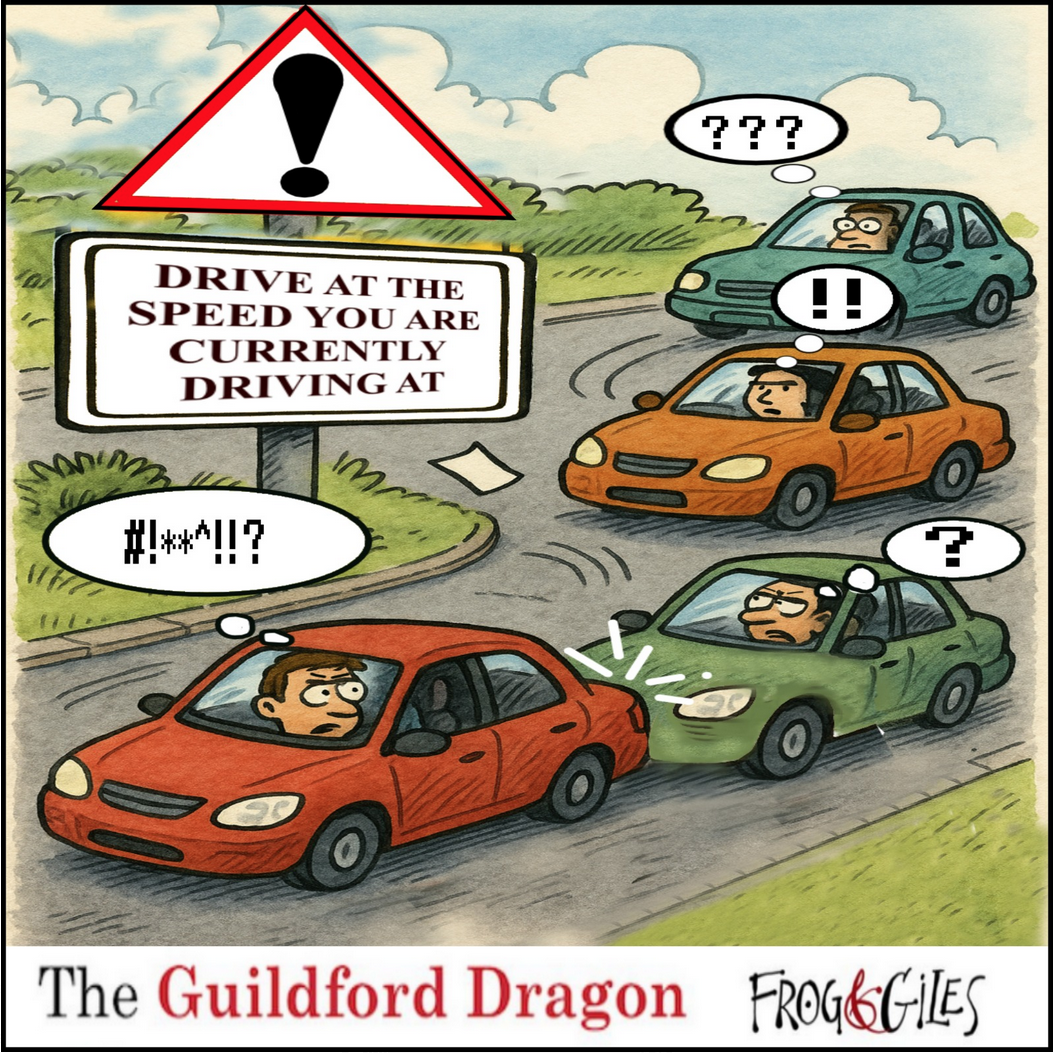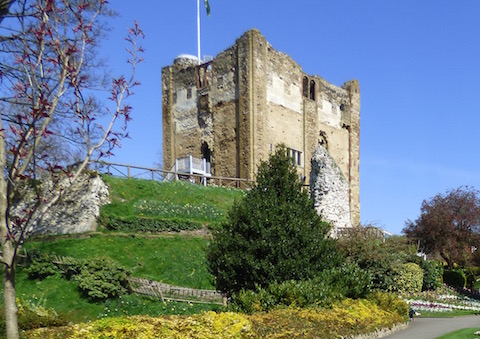 Abraham Lincoln
If given the truth, the people can be depended upon to meet any national crisis...
Abraham Lincoln
If given the truth, the people can be depended upon to meet any national crisis...
 Guildford news...
for Guildford people, brought to you by Guildford reporters - Guildford's own news service
Guildford news...
for Guildford people, brought to you by Guildford reporters - Guildford's own news service
The Normans Are Coming – Right Through Surrey!
Published on: 26 Oct, 2016
Updated on: 26 Oct, 2016
When, in 1066, William the Conqueror invaded England, and following the Battle of Hastings, his army soon moved through the country. It was not long before they swept through parts of Surrey. Here, ELLIOT ROWLAND, who has recently completed a masters degree in history, and whose family lives in Send, recalls those events from his viewpoint.
After the Battle of Hastings in late October 1066, smoke was observed from the tower of St Mary’s church in Guildford. The Normans had come, sweeping through Surrey to establish their rule across Southern England before William seized the throne.

Part of the Bayeux Tapestry that depicts depicts the events leading up to the Norman conquest of England.
The doomed Anglo-Saxon monarchy had denied them entry into their principal objective London, repulsing the Normans days before at the medieval London Bridge, and forced them to circuit the capital, through Surrey.
This article will address when, why and how the Normans first entered Surrey from the fragmentary evidence that survives from that tumultuous period. There is very little evidence surrounding the Norman entry into Surrey because of the political and cultural instability caused by the conquest, but enough survives to the extent that we can glean a rough picture.
The Norman’s first entry into Surrey would have been from the north east, from the direction of London. They would have almost certainly used Stane Street, a Roman road that led directly from London to Chichester, as the paved routes would have been far superior to the dirt roads that would have constituted the average English road in this period.
The first major location on the route was Dorking where William’s army was reinforced from the conquered Norman territories in Southern England, including Kent.
Dorking was important, not only because of its relatively high population and for its industries (with three mills and a poultry market mentioned in the Domesday Book) but because it existed at the convergence of many major roads.
The main Norman army had come from Stane Street but it was another: the so called ‘Pilgrims’ Way’, which would have attracted William the most. This was a major route that William’s reinforcements would have travelled along from Dover, through Kent, to Dorking where they regrouped and resupplied for the circular journey around London.
From Dorking, the ‘Pilgrims’ Way’ wound through the Surrey Hills and was likely used by William’s forces as their main path to major urban centres within Surrey with small detachments of Norman soldiers being used to subjugate or accept the surrender of the surrounding towns, churches and villages.
The Norman’s progress would not have been peaceful. In fact, the Normans are described by many contemporary sources as burning their way through Southern England, Surrey would not have been an exception. The Anglo Saxon Chronicle, a major source of early medieval English history, claims that during 1066 William “harried that part of the country through which he advanced”. This must have included Surrey.
But why was Surrey sacked?
After the Battle of Hastings, William’s continuous victories over the Anglo Saxons would have meant that there was little serious resistance, but the nation was far from conquered.
Sacking was a typical method of medieval military submission through fear. By harrying smaller, less defended settlements, larger and well defended Anglo-Saxon settlements were less willing to resist Norman conquest and gave up rather than face the possibility of a Norman attack.
But this also applied on a larger level. The remaining Anglo-Saxon nobility in London would have been well aware of William’s strategic raiding through Southern England and would have received reports of cities capitulating before him. Perhaps William was also rattling the sabre, daring the Anglo-Saxons to come from London to support key towns like Guildford and Farnham. Were his actions in Surrey an attempt to draw out his enemy?
The Anglo-Saxon Royal Borough of Guildford would have been the second major location on the route through Surrey and the surrounding countryside fell victim to the Norman ravaging.
Reportedly, Bramley and Shalford were attacked with many houses in Bramley and an Anglo-Saxon manor in Shalford being sacked and burned as the Normans advanced. The smoke could be seen from Guildford, from the top of the Anglo Saxon church of St Mary’s built in 1050. There are no references to any Norman attacks in Stoke or Burpham but it is unlikely that the Normans would have left them alone.
Guildford, as one of the two major urban centres in Surrey at the time of the Norman Conquest (with 75 households mentioned in the Domesday Book), was a key Norman target for the submission of the region.
Not only did Guildford exist on a major trading route and the ‘Pilgrims’ Way’, but it was centred around a key fording point on the River Way which, if captured, could have halted an Anglo-Saxon counter attack from London.
Guildford was also the centre for an Anglo-Saxon Royal Mint from 978 with coins struck there showing the image of Æthelred the Unready, Edward the Confessor and Harold Godwinson. William, keen to assert his claim to the throne and likely short on funds, could not ignore such a tempting target.
Whether or not Guildford actively resisted the Normans is unknown, but the evidence that the surrounding settlements were sacked could suggest two things. One, that Guildford presented a significant enough resistance that William did not wish to risk an assault. Or two, that William wanted to take Guildford without entering it, saving him time and allowing him to circumvent the town to his next targets. In any case, after the Normans captured Guildford it is likely that they constructed a wooden motte and bailey castle, the progenitor of the stone Guildford Castle that can be visited today, to consolidate their control over the vital town.
After Guildford, the Normans would have followed the ‘Pilgrims’ Way’ over the Hog’s Back towards Farnham, the other major urban centre in Surrey (40 households mentioned in Domesday).
Farnham was home to one of England’s most important corn markets with six mills and 43 ploughs being mentioned in the Domesday Book which were probably centred on Farnham’s main manor.
Armies needed a massive amount of food, with each man needing, on average, around three pounds of food per day and horses needing around 20 pounds. Farnham would have been an excellent place for resupply and this was probably one of the main reasons another motte and bailey castle was constructed there, another progenitor of the castle that can be explored today.
The ‘Pilgrims’ Way’ took the Normans into Hampshire, to one of their principal objectives, Winchester, which was a major ecclesiastical and political centre for the Anglo-Saxon regime.
William would eventually become king, being crowned on Christmas 1066, and assumed Surrey as part of his royal demesne (land retained by a noble).
By conquering Surrey, William had managed three things. Firstly, he had secured another region of southern England as a base, meaning that he did not need to worry about an Anglo-Saxon attack from his rear flanks.
He was now free to surround London and trap the last of his enemies within the capital.
Secondly, he had shown the Anglo-Saxon monarchy to be inferior and shown the Normans to be superior, which aided his legitimacy to the throne.
Lastly, the Normans had continued to usurp Anglo-Saxon nobles of their titles in Southern England, with members of William’s Familia Regis (military household and nobility) taking over Anglo-Saxon lordships.
Eventually the Norman seizure of land across the rest of England would effectively wipe out the native Anglo-Saxon ruling classes.
Responses to The Normans Are Coming – Right Through Surrey!
Leave a Comment Cancel reply
Please see our comments policy. All comments are moderated and may take time to appear. Full names, or at least initial and surname, must be given.
Click on cartoon for Dragon story: Public Asked for Views on SCC’s Proposal for Reduced Speed Limits


Recent Articles
- Guildford Plans Three-Day Celebration In a Festival of History And Culture
- Local Therapy Garden Supporting Mental Health Shortlisted for BBC Award
- Thousands of Year Six Pupils at Guildford Cathedral for a Special Send Off
- New Surrey Research to Find Solutions to Local Challenges
- Comment: What Are We To Make of the GBC Executive ‘Reshuffle’?
- Bensons for Beds Opens New Store on Guildford High Street
- ‘Politics Is Not Always a Kind Place’ Says Dismissed Lead Councillor
- Local MPs Vote in Favour of Assisted Dying
- Merger Between Reigate & Banstead and Crawley Councils Ruled Out
- Letter: It’s Almost Like We Have Been Abandoned By the Council


Recent Comments
- John Redpath on ‘Politics Is Not Always a Kind Place’ Says Dismissed Lead Councillor
- Jules Cranwell on ‘Politics Is Not Always a Kind Place’ Says Dismissed Lead Councillor
- Ben Paton on ‘Politics Is Not Always a Kind Place’ Says Dismissed Lead Councillor
- Angela Gunning on ‘Politics Is Not Always a Kind Place’ Says Dismissed Lead Councillor
- Nigel Keane on A281 At Shalford Has Now Reopened Following Repairs to Damaged Roof
- N Hatcher on New Electric Trains Now Arriving at Guildford – 100 Years After the First One Did
Search in Site
Media Gallery
Dragon Interview: Local Artist Leaves Her Mark At One of England’s Most Historic Buildings
January 21, 2023 / No Comment / Read MoreDragon Interview: Lib Dem Planning Chair: ‘Current Policy Doesn’t Work for Local People’
January 19, 2023 / No Comment / Read MoreA3 Tunnel in Guildford ‘Necessary’ for New Homes, Says Guildford’s MP
January 10, 2023 / No Comment / Read More‘Madness’ for London Road Scheme to Go Ahead Against ‘Huge Opposition’, Says SCC Leader
January 6, 2023 / No Comment / Read MoreCouncillor’s Son Starts Campaign for More Consultation on North Street Plan
December 30, 2022 / No Comment / Read MoreCounty Council Climbs Down Over London Road Works – Further ‘Engagement’ Period Announced
December 14, 2022 / No Comment / Read MoreDragon Interview: GBC Reaction to the Government’s Expected Decision to Relax Housing Targets
December 7, 2022 / No Comment / Read MoreHow Can Our Town Centre Businesses Recover? Watch the Shop Front Debate
May 18, 2020 / No Comment / Read More









Dinah Bisdee
October 26, 2016 at 3:48 pm
In 1066 the route that is now known as the Pilgrims’ Way would not have been called that, because it was used for pilgrimages to Canterbury only after the martyrdom of Thomas Becket in 1170.
However, it appears that the ‘Way’ itself did previously exist as a track, going back to 5th century BC.
The article also refers to the Domesday Book which of course did not exist in 1066.
Slightly odd to write about these as if they already existed at the time of the Norman Conquest. But still an interesting article, thanks.